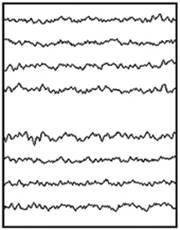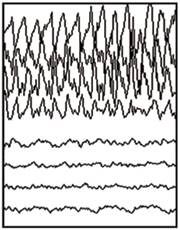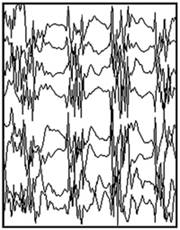Epilepsy: How Seizures Affect the Body
The brain is the “control center” of your body. It manages everything from movement and balance to emotions and memory. When a seizure happens, some or all brain functions are temporarily affected.
|

|

|

|
| Normal EEG |
Partial Seizure EEG |
Generalized Seizure EEG |
The brain working normally
The brain uses electrical signals to send messages throughout your body. Signals sent from different parts of your brain control different body functions. For instance, one part of your brain controls balance. Another part controls speech. A healthcare provider can record brain signals using a test called an electroencephalogram (EEG).
The brain during a seizure
During a seizure, excessive electrical signals in your brain disrupt its normal activity. The way this affects body functions depends on two main factors. First is the location of the seizure in your brain. For instance, a seizure in a part of your brain that controls movement might cause your arm or leg to jerk. The second factor is the type of seizure. For instance, a seizure that affects more of your brain may affect more of your body.
Types of seizures
The two main types of seizures are:
- Partial seizures. These do not involve the whole brain.
- Generalized seizures. The whole brain is involved. A partial seizure can become generalized.
Partial seizures (do not involve the whole brain)
Also called focal seizures, these seizures start in 1 part of your brain. There are two types:
- Simple partial seizures. These may start with an aura, or warning. Auras are an unusual sense or feeling that indicates that a seizure will soon happen. Auras can involve strange tastes or smells, stomach upset, or a feeling of fear or déjà vu. Simple partial seizures may also involve jerking movements or hallucinations. You are awake and aware that you are having a simple seizure.
- Complex partial seizures. These may also start with an aura. You may become motionless and have a vacant stare, or you may perform “automatisms.” These are repeated movements, such as smacking lips or gesturing. A complex seizure means there is a change or loss of consciousness. If you have a complex seizure, you may be awake but unaware of the seizure.
Generalized seizures (involves the whole brain)
These seizures affect your entire brain at once. They usually start happening at a young age. The most common types of generalized seizures are:
- Absence seizures (petit mal seizures). These seizures involve a brief lapse of awareness. Signs can include staring, eye blinking, and lip smacking.
- Tonic-Clonic seizures (grand mal seizures). These may be the best known type of seizure. You lose consciousness and may fall to the ground. Your body stiffens and then convulses, with your arms and legs jerking rhythmically.
- Myoclonic seizures. These seizures involve brief jerking movements. They usually affect both sides of your body.
- Atonic seizures (drop attacks). During these seizures, you lose all muscle control and may fall or slump over.
Epilepsy: How Seizures Affect the Body
The brain is the “control center” of your body. It manages everything from movement and balance to emotions and memory. When a seizure happens, some or all brain functions are temporarily affected.
|

|

|

|
| Normal EEG |
Partial Seizure EEG |
Generalized Seizure EEG |
The brain working normally
The brain uses electrical signals to send messages throughout your body. Signals sent from different parts of your brain control different body functions. For instance, one part of your brain controls balance. Another part controls speech. A healthcare provider can record brain signals using a test called an electroencephalogram (EEG).
The brain during a seizure
During a seizure, excessive electrical signals in your brain disrupt its normal activity. The way this affects body functions depends on two main factors. First is the location of the seizure in your brain. For instance, a seizure in a part of your brain that controls movement might cause your arm or leg to jerk. The second factor is the type of seizure. For instance, a seizure that affects more of your brain may affect more of your body.
Types of seizures
The two main types of seizures are:
- Partial seizures. These do not involve the whole brain.
- Generalized seizures. The whole brain is involved. A partial seizure can become generalized.
Partial seizures (do not involve the whole brain)
Also called focal seizures, these seizures start in 1 part of your brain. There are two types:
- Simple partial seizures. These may start with an aura, or warning. Auras are an unusual sense or feeling that indicates that a seizure will soon happen. Auras can involve strange tastes or smells, stomach upset, or a feeling of fear or déjà vu. Simple partial seizures may also involve jerking movements or hallucinations. You are awake and aware that you are having a simple seizure.
- Complex partial seizures. These may also start with an aura. You may become motionless and have a vacant stare, or you may perform “automatisms.” These are repeated movements, such as smacking lips or gesturing. A complex seizure means there is a change or loss of consciousness. If you have a complex seizure, you may be awake but unaware of the seizure.
Generalized seizures (involves the whole brain)
These seizures affect your entire brain at once. They usually start happening at a young age. The most common types of generalized seizures are:
- Absence seizures (petit mal seizures). These seizures involve a brief lapse of awareness. Signs can include staring, eye blinking, and lip smacking.
- Tonic-Clonic seizures (grand mal seizures). These may be the best known type of seizure. You lose consciousness and may fall to the ground. Your body stiffens and then convulses, with your arms and legs jerking rhythmically.
- Myoclonic seizures. These seizures involve brief jerking movements. They usually affect both sides of your body.
- Atonic seizures (drop attacks). During these seizures, you lose all muscle control and may fall or slump over.
Epilepsy: How Seizures Affect the Body
The brain is the “control center” of your body. It manages everything from movement and balance to emotions and memory. When a seizure happens, some or all brain functions are temporarily affected.
|

|

|

|
| Normal EEG |
Partial Seizure EEG |
Generalized Seizure EEG |
The brain working normally
The brain uses electrical signals to send messages throughout your body. Signals sent from different parts of your brain control different body functions. For instance, one part of your brain controls balance. Another part controls speech. A healthcare provider can record brain signals using a test called an electroencephalogram (EEG).
The brain during a seizure
During a seizure, excessive electrical signals in your brain disrupt its normal activity. The way this affects body functions depends on two main factors. First is the location of the seizure in your brain. For instance, a seizure in a part of your brain that controls movement might cause your arm or leg to jerk. The second factor is the type of seizure. For instance, a seizure that affects more of your brain may affect more of your body.
Types of seizures
The two main types of seizures are:
- Partial seizures. These do not involve the whole brain.
- Generalized seizures. The whole brain is involved. A partial seizure can become generalized.
Partial seizures (do not involve the whole brain)
Also called focal seizures, these seizures start in 1 part of your brain. There are two types:
- Simple partial seizures. These may start with an aura, or warning. Auras are an unusual sense or feeling that indicates that a seizure will soon happen. Auras can involve strange tastes or smells, stomach upset, or a feeling of fear or déjà vu. Simple partial seizures may also involve jerking movements or hallucinations. You are awake and aware that you are having a simple seizure.
- Complex partial seizures. These may also start with an aura. You may become motionless and have a vacant stare, or you may perform “automatisms.” These are repeated movements, such as smacking lips or gesturing. A complex seizure means there is a change or loss of consciousness. If you have a complex seizure, you may be awake but unaware of the seizure.
Generalized seizures (involves the whole brain)
These seizures affect your entire brain at once. They usually start happening at a young age. The most common types of generalized seizures are:
- Absence seizures (petit mal seizures). These seizures involve a brief lapse of awareness. Signs can include staring, eye blinking, and lip smacking.
- Tonic-Clonic seizures (grand mal seizures). These may be the best known type of seizure. You lose consciousness and may fall to the ground. Your body stiffens and then convulses, with your arms and legs jerking rhythmically.
- Myoclonic seizures. These seizures involve brief jerking movements. They usually affect both sides of your body.
- Atonic seizures (drop attacks). During these seizures, you lose all muscle control and may fall or slump over.